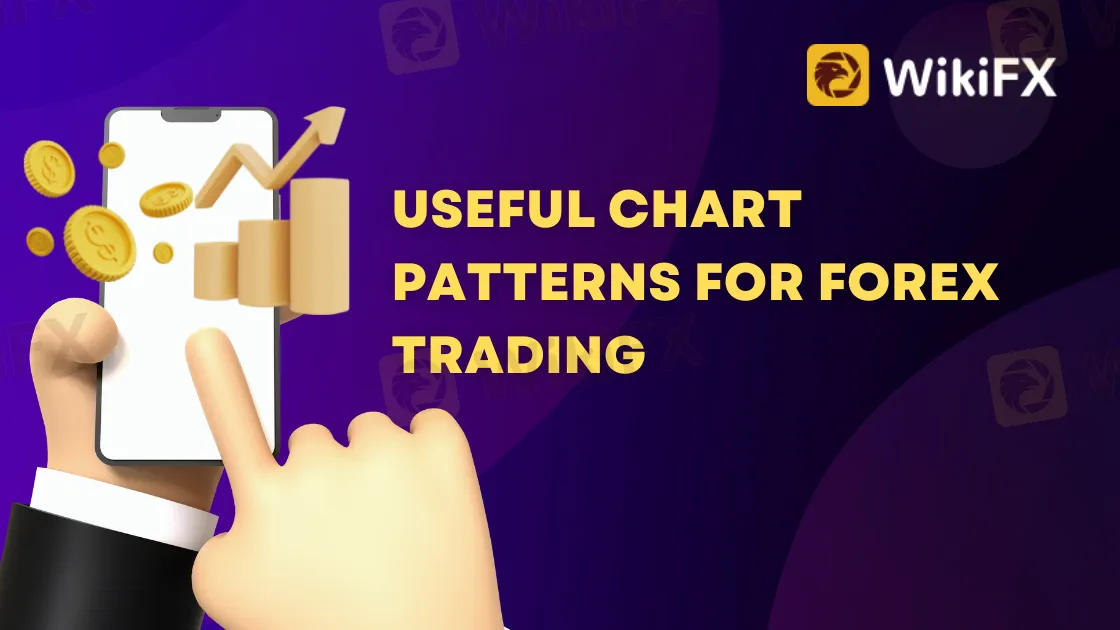简体中文
繁體中文
English
Pусский
日本語
ภาษาไทย
Tiếng Việt
Bahasa Indonesia
Español
हिन्दी
Filippiiniläinen
Français
Deutsch
Português
Türkçe
한국어
العربية
Useful Chart Patterns For Forex Trading
Abstract:Technical analysis includes chart patterns because they can help forex traders find trends, movements, and patterns in the way currency prices change. You will be able to benefit from these technical pricing patterns if you learn about these chart patterns.

There are several chart patterns, and we have already shown some fundamental and effective candlestick patterns. In this post, we will go over 10 more typical chart patterns that you should be aware of while trading in the forex market.
1. Head and Shoulders
One of the most reliable reversal chart patterns is the head and shoulders. This design, which resembles a head with two shoulders, has a huge peak in the center and smaller peaks on each side. The head and shoulders pattern indicates that the price will fall.

The first and third peaks will be smaller than the second, but they will all fall back to the same level of support, often known as the 'neckline,' as seen in the chart above. Once the third high has dropped back to the level of support, the market is likely to enter a bearish downturn.
2. Reverse Head and shoulders
The reverse head and shoulders pattern, on the other hand, happens after a downward trend and predicts an upward surge. An HS top means the end of a rising trend, while an HS bottom means the end of a falling trend and that prices may be about to go up.

The pattern can be seen when the price falls to a trough and then rises; when the price falls below the first trough and then rises again; and when the price falls again, but not as far as the second trough.
3. Double Top
A double top is another common bearish reversal pattern used by traders. It has two peaks, signaling dwindling buyer interest and the probability of a downturn. The “tops” are peaks that occur when the price reaches a level that cannot be breached. After reaching this level, the price will briefly bounce off it before returning to test it again.

The chart above shows that a top was created after a strong advance up and then a retracement down to a level of support. It will then produce another high before reversing from the current trend.
4. Double Bottom
The double bottom pattern, on the other hand, is a bullish reversal pattern that is diametrically opposed to the double top. This pattern has two low points in price, which show that buyers are becoming more interested and the price is likely to go up.

The chart above shows that following the last decline, the price developed two valleys since it couldn't fall below a particular level. The price then broke through the neckline and made a solid run higher.
5. Rising Wedge
As market fluctuations constrict between two sloping trend lines, wedges develop. The wedge comes in two varieties: rising and falling. A rising wedge happens when the price rises over time. Rising wedges indicate a bullish trend reversal, forming a negative market situation.

6. Falling Wedge
Falling wedges, on the other hand, are bullish. A falling wedge is formed by two downwardly sloping levels. As you can see in the image below, a falling wedge usually means that the price will go up and break through the level of resistance.

7. Ascending Triangle
The ascending triangle is a bullish continuation pattern that shows that the price is still going up. It can also show up as a reversal pattern near the end of a downward trend, but it is more often seen as a continuation pattern. A rising triangle happens when the price follows a rising trend line and then stops moving.

8. Descending Triangle
The descending triangle, like the ascending triangle, is a continuation chart pattern. The only difference is that it's a bearish continuation pattern that forms when the price goes down.
It may also form a reversal pattern towards the conclusion of an uptrend, however, it is more frequently regarded as a continuation chart pattern.

9. Symmetrical Triangle
An upper trendline connects a series of decreasing peaks and a lower trendline connects a series of rising troughs to form symmetrical triangular patterns. This pattern often indicates a time of consolidation inside a trend, after which the trend may restart. Furthermore, volatility often decreases as the pattern progresses. Symmetrical triangles may imply either bearish or bullish markets, and a breakout in either way marks the start of a new trend.

10. Bottom rounding
A chart pattern with a rounded bottom could mean either that the trend will continue or that it will change. During an upswing, for example, an asset's price may decline somewhat before rising again. This is a bullish continuation.
As you can see below, a bullish reversal rounding bottom would happen if the price of an asset was going down and a rounding bottom formed before the trend changed and started going up.

Stay tuned for more Forex Educational Articles.
Download the WikiFX App from the App Store or Google Play Store to stay updated on the latest news.

Disclaimer:
The views in this article only represent the author's personal views, and do not constitute investment advice on this platform. This platform does not guarantee the accuracy, completeness and timeliness of the information in the article, and will not be liable for any loss caused by the use of or reliance on the information in the article.
Read more

Want to be Sure of a Forex Settlement Process? Read This IMPORTANT Guide!
Forex settlements are complex—and missteps can cost millions. This guide breaks down CLS, the global standard in FX settlement, so you can reduce risk and streamline cross-border transactions.

Valid Reasons to Avoid SevenStar FX
SevenStar FX is a low-rated broker. When you search online, you will find tons of overly positive reviews about this broker. Strangely, there is almost no negative feedback anywhere, which is unusual. It makes us wonder: how can a forex broker with no proper regulation have such a perfect reputation? In this article we exposed the red flags of this broker.

Top 5 Forex Risk Management Errors Companies Usually Commit
Think your company’s forex strategy is under control? Think again. Even large organizations fall prey to hidden currency risks that can quietly eat into their margins. From overlooked exposures to outdated strategies, here are the top five forex risk management errors businesses make—and how to avoid them.

How to Use a Free Forex Trading Bot for Big Profit
Learn how to maximize your profits with free forex trading bots, set them up easily, and avoid common mistakes that can cost you big in automated trading.
WikiFX Broker
Latest News
CNBC Daily Open: The silver lining of positive earnings could be too blinding
Brexit made businesses abandon the UK. Trump's hefty EU tariffs could bring them back
CNBC Daily Open: Solid earnings beats might mask tariff volatility these two weeks
Mastering Deriv Trading: Strategies and Insights for Successful Deriv Traders
Jeep-maker Stellantis expects first-half net loss of $2.7 billion as tariffs bite
U.S. doubles down on Aug. 1 tariffs deadline as EU battles for a deal
Buffett and Thorp’s Secret Options Strategies
Trading Market Profile: A Clear and Practical Guide
Sharing Trading Mistakes and Growth
Eyeing Significant Returns from Forex Investments? Be Updated with These Charts
Currency Calculator


